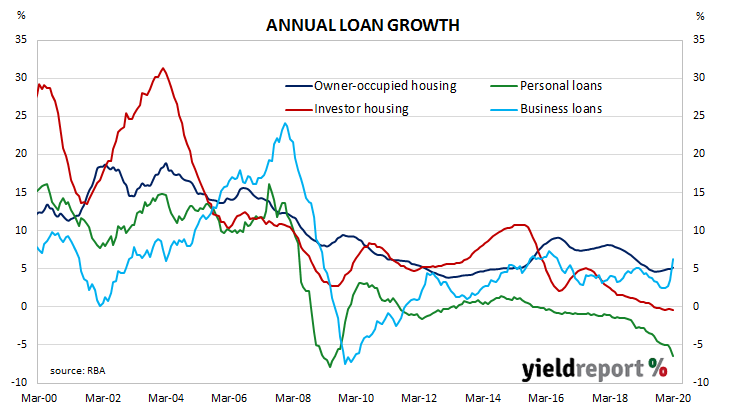The pace of lending to the non-bank private sector by financial institutions in Australia has been trending down since October 2015. Private sector credit growth appeared to have stabilised in the September quarter of 2018 but the annual growth rate then continued to deteriorate through 2019.
While senior RBA officials would like business lending to increase, those same officials would also like households to reduce debt. In early 2020, RBA Governor Philip Lowe publicly stated the cash rate had been reduced in part to assist households in this objective. However, the likelihood of either has been greatly reduced by recent events.
According to the latest RBA figures, private sector credit grew by +1.1% in March, well above the +0.3% increase which had been expected and well above February’s +0.4% increase. The annual growth rate moved higher, from February’s revised annual rate of 2.7% to 3.6%.
The increase over the month was overwhelmingly driven by business lending. Lending to owner-occupiers rose modestly while lending to real estate investors and for personal purposes declined. ANZ economist Hayden Dimes said, “The strong growth was driven by business credit, which rose 2.9%. You have to go back over 30 years to 1988 to see a stronger monthly figure for business credit.”
ANZ economist Hayden Dimes said, “The strong growth was driven by business credit, which rose 2.9%. You have to go back over 30 years to 1988 to see a stronger monthly figure for business credit.”
Local Treasury bonds yields remained stable to a certain degree. By the end of the Australian trading day, the 3-year Treasury bond yield remained unchanged at 0.25%, the 10-year yield had lost 3bps to 0.89% and the 20-year yield finished unchanged at 1.51%.
In the cash futures market, expectations of a rate cut continued to harden. At the close of business, May contracts implied a rate cut down to zero as a 64% chance, up a little from the previous day. June contracts implied a 58% chance of such a move, unchanged, while July contracts implied a 70% chance, up from 67%. Contract prices of months in the remainder of 2020 and through to mid-2021 implied similar probabilities, ranging between 50% and 65%.

